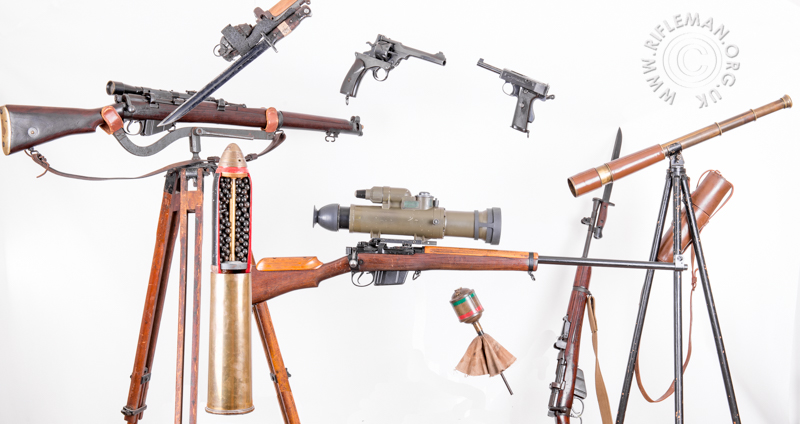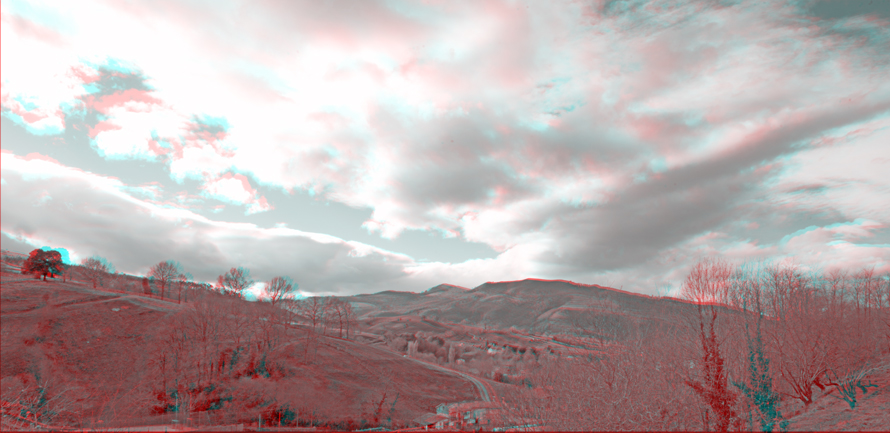to be viewed using Red / Cyan coloured 3D glasses cheaply and easily available,
at less than 1 euro, from many online retail sources

Viewing these images with the economical cardboard spectacles gives reasonable results,
but the use of a pair of more substantial specially made glasses does give better perception.
Sadly, it is also a fact of life that some people are better able to accustom their eyes
to detecting the artificial stereo three dimensional effect than others.
First shown is a static image of a Nikon camera.
The effect is no doubt one of the best on this page,
and, if you move your head left and right,
the lens almost appears to follow you.
SEE HOW THESE ANAGLYPHIC IMAGES ARE PRODUCED
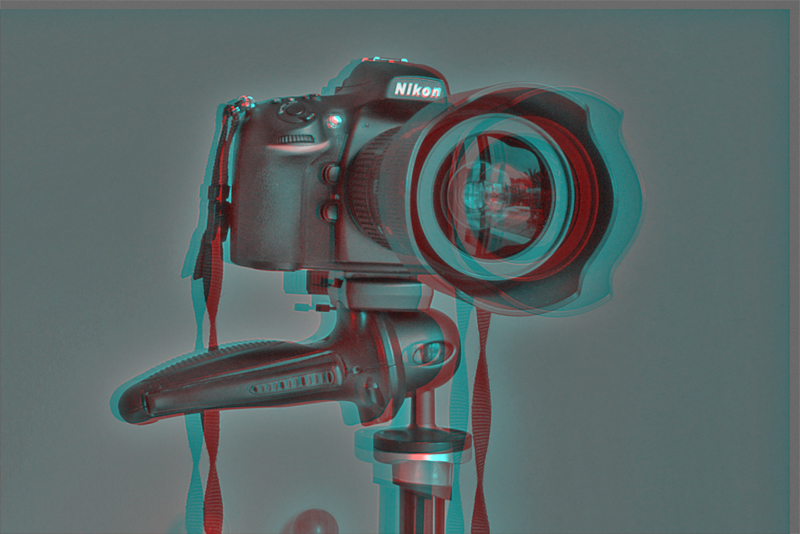
Next, in relation to this website's remit,
we show rotating imagery of two Lee-Enfield sniper rifles
in the company of a small number of other British weapons and accessories.
First - the imagery is shown in plain photographic form for comparison.
Drag horizontally to rotate subject.
Click to zoom and drag to pan.
Full screen viewing from expansion arrows.
and secondly - the stereoscopic anaglyph version, requiring the Red / Cyan "3D" spectacles.
and, for those who may wish to know what are the various items in the display, a legend is given below.

LEGEND
1. Lee-Enfield 7.62mm NATO calibre L42A1 Sniper rifle with image intensifying IWS (Individual Weapon Sight) - of 1971 to Falklands war vintage.
2. WW1 18 pounder sectioned shrapnel artillery shell.
3. S.M.L.E. (Short Magazine Lee-Enfield WW1 .303 inch calibre sniper rifle with side-mounted Periscopic Prism Company telescopic sight - 1916 vintage - on a rifle aiming practice tripod stand.
4. A 1907 DP (Drill Practice) S.M.L.E. bayonet with attached WW1 No.1 Grenade Discharger and No.23 Mills Rifle Grenade (a No.5 with rod attached) - 1916 vintage
5. A pre-WW1 Webley Fosbery early semi-automatic revolver in British .455 inch calibre - an officer's pre-WW1 private purchase.
6. A Webley .455 inch calibre automatic pistol - 1909 Naval model - another private purchase circa 1913.
7. A Scout Regiment 3-draw sniper/observer's spotting telescope - these were used during both World Wars - this is a WW2 Mk.II that would have been issued with the Lee-Enfield No.4T sniper rifle, and continued in use when these were converted to the 7.62mm L42A1 rifle central in this imagery.
8. An Australian Lee-Enfield No.6 trials rifle - late WW2 vintage.
9. The first British WW1 anti-tank rifle grenade; the No.44 - 1918 vintage
The story behind this last image set started with the thought that our rotating imagery of the rifles on site
could perhaps be enhanced by 3D viewing, and the only way of simply achieving this online is by anaglyph.
Obviously such images are of no use to a viewer without the appropriate glasses,
but we thought they could at least be of some amusement to any reader who cares to obtain a pair.
We first experimented with a static image
of an Air Arms CZ200 PSP air rifle with a telescopic sight,
such as would be used for field work and/or competition.

The above image showed promise, so we then set up a pair of rifles
and a scout regiment telescope on its original tripod.
Our first static Lee-Enfield display was a Photoshop processed version,
synchronised at the focus point of the support rod.
In photo processing software, separation of the two required images can be adjusted by eye,
sliding the upper layer from side to side on screen to achieve best effect.
The telescope and second rifle are there to increase the depth appearance and parallax effect.
The comment on how this was done is explained in the page's section HERE

Next, the same pair of Lee-Enfield rifle photographs were processed,
in almost one simple stage, using the free StereoPhoto Maker application
and auto-synched by the software, (which has been recently updated).
It can be found HERE

SPM is fine for simple single images, but our work is a little more complex,
and requires the employment of two Adobe software programmes, Lightroom and Photoshop.
ROTATE & ZOOM 3D IMAGERY
The next step was to turn a static 3d image into a rotational version.
This usually requires 72 photographs to be taken in 36 separated pairs,
each pair then beng processed into cyan and red layers
before being combined into an anaglyph.
This was our first such experiment, and when the following rotating image has loaded,
the subject can be spun by dragging left to right across the image.
There are just 26 images in this trial set for the 360 degree rotation;
increasing this to 36 smooths the movement significantly.
The "base" used (the lateral displacement of the camera between each of the photographs in a pair)
was only a matter of a few inches; a wide-angled lens was used,
and the camera was quite close to the main subject.
The "pop-out" effect achieved was quite remarkable.
HOW ARE ANAGLYPHIC IMAGES PRODUCED
If you are not interested in the science behind the photographs,
There are more to see after this explanation.
Such images are obtained by merging two photographs
taken a short lateral distance apart (the BASE).
The two images are first processed in photo software
to remove the blue and green from one image, and the red from the other.
One is then pasted over the other to give the red/cyan offset.
That base distance is dictated by two main factors;
the nearest distance to the camera, and the greatest distance from the camera.
The correct calculation must needs also include details of the lens used and relative heights.
The simplest way of obtaining the correct set up is to use a calculator,
and we illustrate below one that works well.
This is in the form of a proprietary spreadsheet, with our own additional table at the side
that allows figures to be input for the equivalency between
a 35mm or full-frame digital camera, and the 4/3 reduced sized sensor of a compact camera.
The settings in this spreadsheet example are for a Nikon 1 compact camera
with a 10-30mm lens set at its widest focal length.
The subject's nearest distance to the camera sensor is 70cms, and the furthest is 130cms.
The base calculates out at 110.8mm,
and relates to a photograph of an air rifle further down this page.
The lens is focused on the support rod at 91cms.
The parallax setting can be altered, and would normally be set at 1.8
for normal 35mm equivalent focal lengths.
Raising this figure (here to 2.4) increases the pop-out effect,
but proportionately distorts the image.

You can download this amended XL spreadsheet from HERE
Chapter and verse on this stereoscopy calculator, using the Bercovitz formula, is available HERE
Close work is best achieved with a tape measure,
but this is impracticable for landscapes,
and at long distance can be set up by pacing,
as the base distance may be quite large to obtain best results.
Whilst it is perfectly possible to take one photograph
and move the camera the appropriate distance by hand to take the second,
if accurate results are required it is preferable to use a slider on a tripod for short distance work.

Not all the anaglyphs we show are as good as the first one, by any stretch of the imagination,
but some of them are quite three-dimensionally representative,
and each of them has its own appeal if you are able to discern the effect.
Our first of the next static image subjects offers you a chance to be stared at by "Google"!

The second static image is of a "Bottlebrush" flower
The third image is of the Zeppelin L33 which crash -landed at Little Wigborough,
Essex, on 24th. September 1916, after suffering battle damage from both anti-aircraft fire
and attacking RFC aircraft over London during a bombing run.
Despite jettisoning much equipment, the commander was unable to reach the sea
to continue home or ditch, and landed the craft to allow the crew to safely disembark.
The crew destroyed their ship by setting it alight,
prior to peaceably surrendering to a local constable.
The image is an experimental anaglyphic rendition of
an original stereoscopic pair of monochrome photographs
that would have been viewed using a stereoscope.
Being scanned low resolution images,
they are not as effective as would be modern photos specially taken.

Other staged photographs can be entertaining to both set up and view.
The Christmas tree

The Dovercourt leading-lighthouses, in Essex.

A hillside view
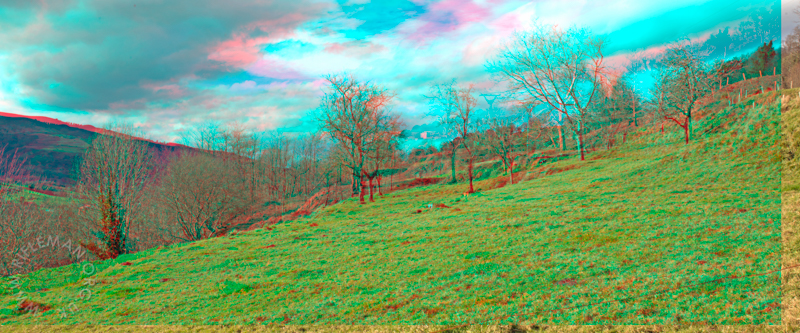
A garden bench in sun against a dark sky

A garden chair
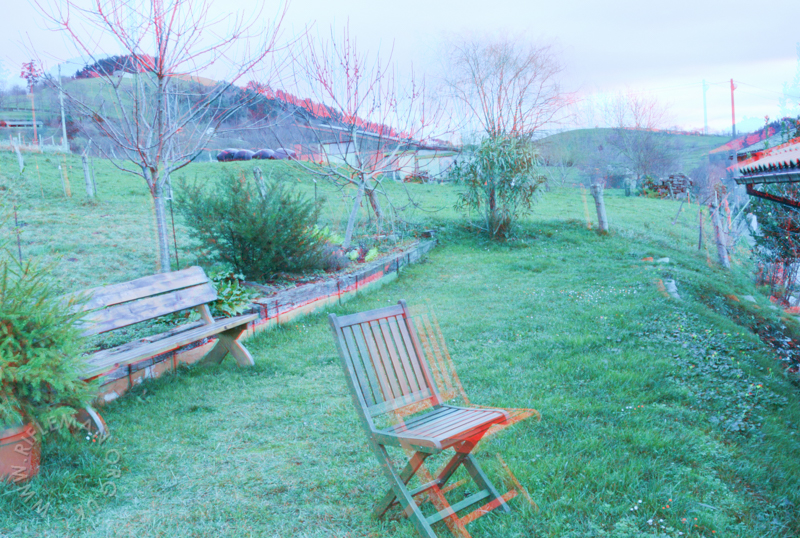
This palm tree shows reasonably well against a fairly indifferent background,
Not the best of images, but this is just to illustrate the effect of different base distances.
That on the left is taken at 125mm, and that on the right is doubled to a 250mm base.
 .......
.......
Near subjects can be quite effective against a distant background
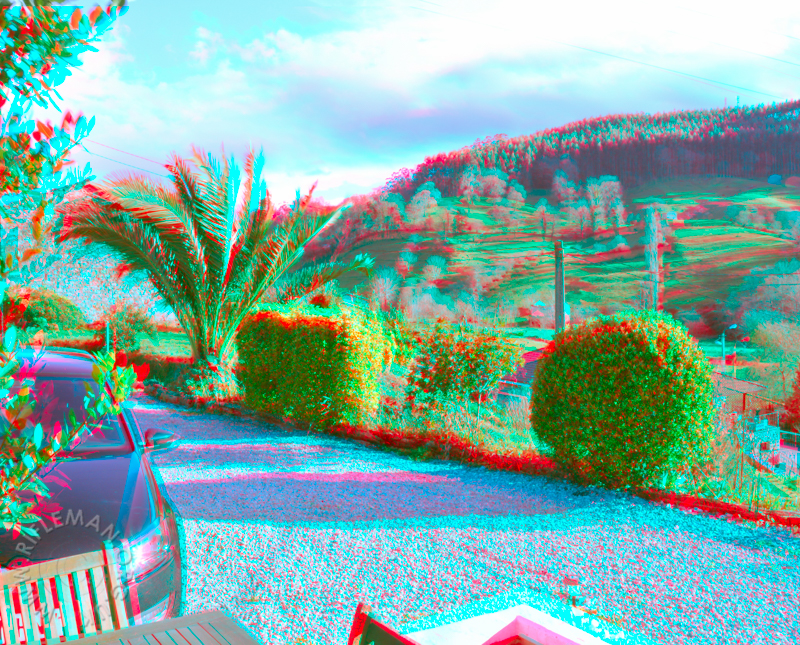
Cars can also make good subjects, but it can be tricky
to arrange a background that affords the parallax required for best effect..
These images have been taken at a distance such as
might be normally used for casually photographing a vehicle,
quickly and simply by guesswork, without checking with a calculator;
but a greater " stand out" effect than this could be achieved by closer photography,
with a wider angle lens, tripod and a measured base.

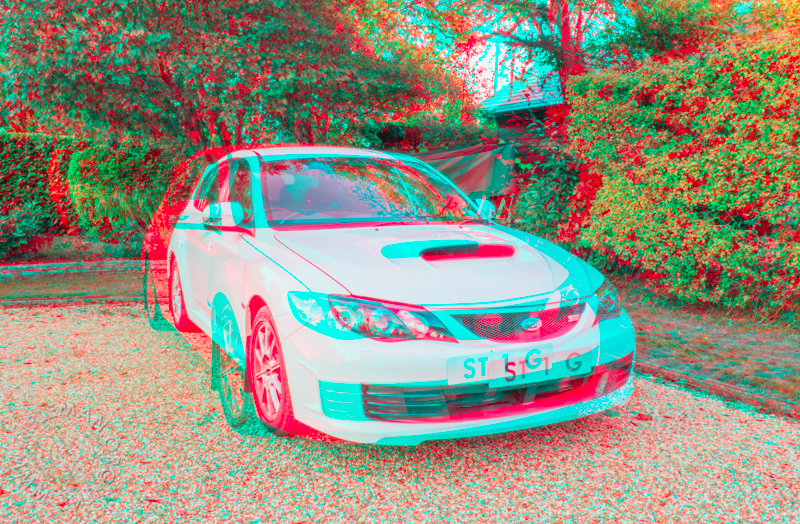
The next static image is a hyperstereoscopic monochrome long distance landscape
of ...... "Argomeda from Escobedo" - Cantabria
CLICK ON THIS IMAGE FOR A HIGH-RESOLUTION COLOUR VERSION
(zooming in to the linked colour image will accentuate the 3D effect)
Use your browser's BACK button, or the provided link, to return to this page
_____________________________________________________________________________________________________
